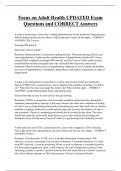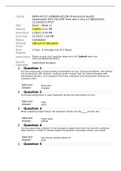Focus on Adult Health UPDATED Exam
Questions and CORRECT Answers
A nurse is monitoring a client who is taking spironolactone for the treatment of hypertension.
Which findings denote adverse effects of the medication? Select all that apply. - CORRECT
ANSWER- Tall T waves
Prolonged PR interval
Hyperactive bowel sounds
Rationale: Spironolactone is a potassium-sparing diuretic. Potassium-sparing diuretics can
cause hyperkalemia. Cardiovascular manifestations of hyperkalemia include tall T waves,
widened QRS complexes, prolonged PR intervals, and flat P waves. Other cardiovascular
manifestations include an irregular heart rate, decreased blood pressure, and ectopic
heartbeats. Muscle twitches occur in hyperkalemia. Hyperactive bowel sounds and diarrhea
also occur in hyperkalemia. Constipation, hyporeflexia, and shallow respirations are signs of
hypokalemia.
A nurse is providing dietary instructions to a client with chronic obstructive pulmonary
disease (COPD) who is experiencing a loss of appetite and complains of feeling "too full to
eat." What does the nurse encourage the client to do? Select all that apply. - CORRECT
ANSWER- Avoid drinking fluids before and during meals
Select foods that are easy to chew and are not gas forming
Rationale: COPD is a progressive and irreversible condition characterized by diminished
inspiratory and expiratory capacity of the lungs. Instruct the client who complains of feeling
too full to eat, to avoid drinking fluids before and during the meal. Dry foods such as crackers
stimulate coughing; foods such as milk and chocolate may increase the thickness of saliva
and secretions. Cheese is constipating and should also be avoided by the client. The nurse
should also teach the client about foods that are easy to chew and do not encourage the
formation of gas; for this reason, broccoli, which is a gas-forming food, should be avoided.
A tuberculin skin test (TST) is administered to a client with a diagnosis of HIV infection.
Forty-eight hours after administration, the nurse checks the test site (see image). - CORRECT
ANSWER- Positive
Rationale: The tuberculin, or TST, test is a reliable determinant of tuberculosis (TB)
infection. A reaction measuring 5 mm or more in diameter is considered positive in a client
with HIV infection. A reaction measuring 10 mm or more in diameter is considered positive
in a non-immunosuppressed client. In this instance, the area of induration measures 9 mm,
indicating a positive reaction. A positive reaction does not mean that active disease is present,
but it does indicate exposure to TB or the presence of inactive (dormant) disease.
,A nurse is interpreting a central venous pressure (CVP) reading from a client in whom right
ventricular failure has been diagnosed. From this diagnosis, the nurse would expect that the
most likely result is a pressure of - CORRECT ANSWER- 14 cm H2O
Rationale: CVP measurements are used to monitor blood volume and the adequacy of venous
return to the heart. The CVP measures pressures from the right atrium or central veins. The
normal CVP is 7 to 12 cm H2O. An increased CVP reading may indicate right ventricular
failure. A low CVP reading may indicate hypovolemia. A reading of 4 cm H2O is low.
Readings of 8 and 11 cm H2O are normal. A reading of 14 cm H2O is increased.
A nurse is caring for a client who has just undergone thyroidectomy. Which technique is the
best way for the nurse to assess the surgical site for bleeding? - CORRECT ANSWER-
Checking for moisture on the back of the dressing over the client's neck and shoulders
Rationale: Thyroid surgery may be complicated by hemorrhage, respiratory distress,
parathyroid gland injury (resulting in hypocalcemia and tetany), damage to the laryngeal
nerves, and thyroid storm. Hemorrhage is most likely during the 24 hours after surgery. If the
client is bleeding after surgery, gravity will cause the blood to seep down the sides of the
dressing and drain onto the underlying bed linens even as the top of the dressing remains
clean and dry. Asking the client whether the dressing feels wet and replacing the dry sterile
dressing every 2 hours are not the best actions. Replacing the dressing frequently when it is
not warranted could also increase the risk of infection.
A client who sustained a major burn injury is beginning to take an oral diet again. Which
between-meal menu selections meet the client's needs for wound healing and tissue repair?
Select all that apply. - CORRECT ANSWER- Whole-milk shake and granola
Baked potato topped with cheese
Cheese and whole-wheat crackers
Rationale: To facilitate healing and meet continued high metabolic needs, the client with a
major burn should eat a diet high in calories, protein, and carbohydrates. This type of diet
also keeps the client in positive nitrogen balance. Foods such as milkshakes, granola, cheese,
and whole-wheat products are acceptable choices. Though fresh fruits and vegetables and
skim milk are high in nutrients, higher-calorie foods, including versions of dairy products
prepared with whole milk, are preferable in this situation.
A client is found to have hypoparathyroidism. Which nutritional supplement does the nurse,
teaching the client about measures to manage the disorder, tell the client to take on a daily
basis? - CORRECT ANSWER- Calcium carbonate with vitamin D
Rationale: Hypoparathyroidism is an endocrine disorder in which parathyroid function is
decreased. The client with hypoparathyroidism is likely to have low calcium and high
, phosphate levels and should consume a diet high in calcium but low in phosphorus.
Additionally, the generally used treatment is calcium supplementation (either as calcium
carbonate or calcium citrate) coupled with vitamin D supplementation. Vitamin C
supplementation is not a treatment measure for this disorder. Beta-carotene is incorrect,
because a client with hypoparathyroidism typically has an increased phosphorus level
A nurse participating in a free health screening at the local mall obtains a random blood
glucose level of 190 mg/dL (10.6 mmol/L) and a total cholesterol level of 210 mg/dL (5.4
mmol/L) in an otherwise healthy client. What should the nurse tell the client to do next? -
CORRECT ANSWER- Call his health care provider to have these values rechecked as soon
as possible
Rationale: Adult diabetes mellitus may be diagnosed on the basis of symptoms (e.g.,
polydipsia, polyuria, polyphagia) or laboratory values. An abnormal glucose tolerance test, a
random plasma glucose level greater than 200 mg/dL (11.1 mmol/L), and a fasting plasma
glucose level greater than 140 mg/dL (7.8 mmol/L) on two separate occasions are all
diagnostic of diabetes mellitus. The total cholesterol should be less than 200 mg/dL (5.2
mmol/L). Confirmation of this client's results is needed to ensure appropriate diagnosis and
therapy.
Levothyroxine sodium is prescribed for a client with hypothyroidism, and the nurse provides
information to the client about the medication. Which occurrences does the nurse tell the
client to report to the health care provider? Select all that apply. - CORRECT ANSWER-
Chest pain
Palpitations
Rapid heart rate
Rationale: The client taking levothyroxine sodium may have manifestations of
hypothyroidism if the dosage is inadequate or may experience manifestations of
hyperthyroidism if the dosage is too high. Thyroid preparations increase metabolic rate,
oxygen demands, and demands on the heart, which may result in angina and cardiac
dysrhythmias. The client should be instructed to report chest pain, palpitations, or a rapid
heart rate immediately. Lethargy, constipation, and weight gain are symptoms of
hypothyroidism, which should improve with medication therapy (e.g., levothyroxine sodium).
A nurse is developing a plan of care for an older client with diabetic neuropathy of the lower
extremities resulting from type 2 diabetes mellitus. Which problem does the nurse recognize
as the highest priority for this client? - CORRECT ANSWER- Increased risk for injury
Rationale: The client with diabetic neuropathy of the lower extremities has a diminished
sensation in the legs and feet. This client is at risk for tissue injury and for falls as a result of
this nervous system impairment. Therefore the highest priority nursing problem is increased
risk for injury. Increased risk of depression and change in body image are more psychosocial





